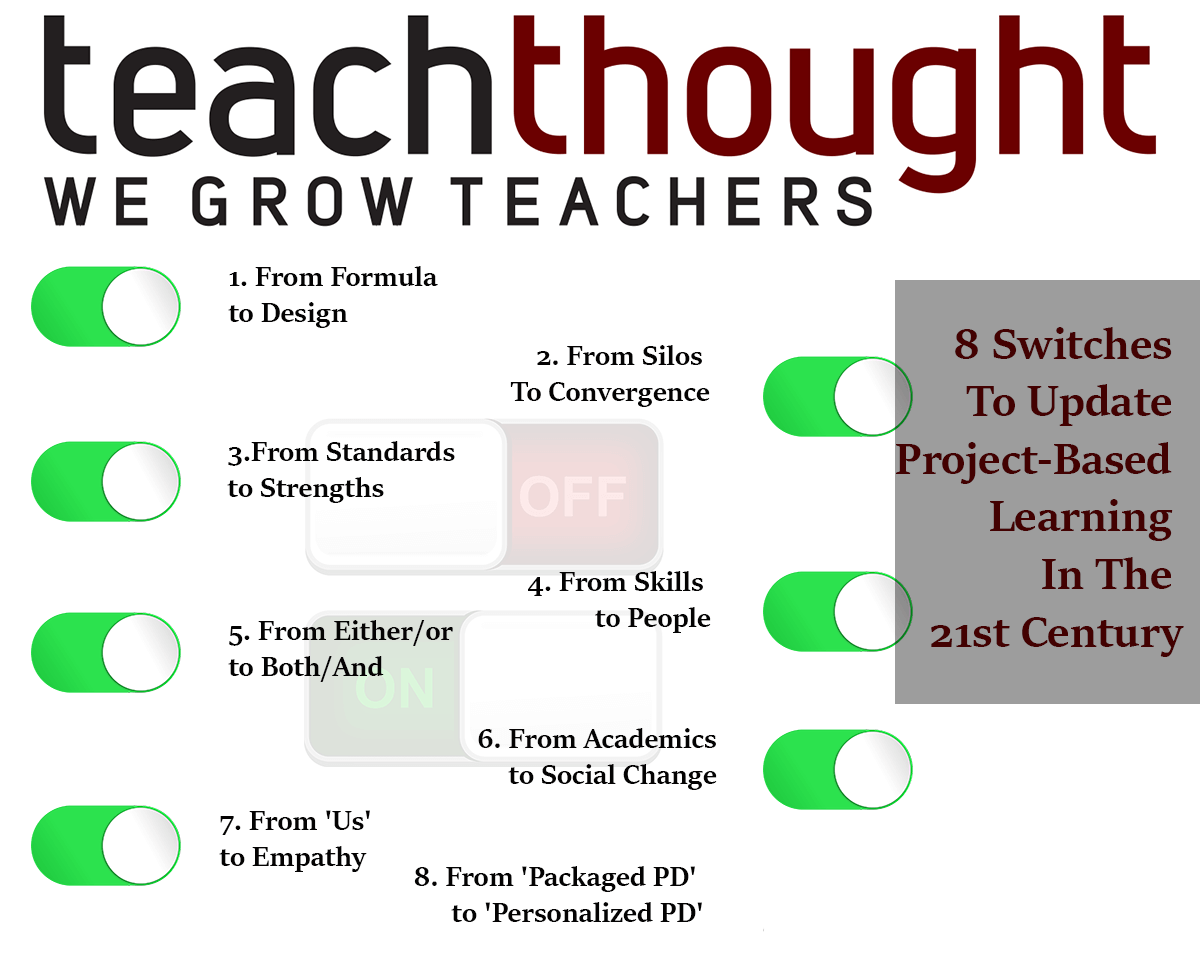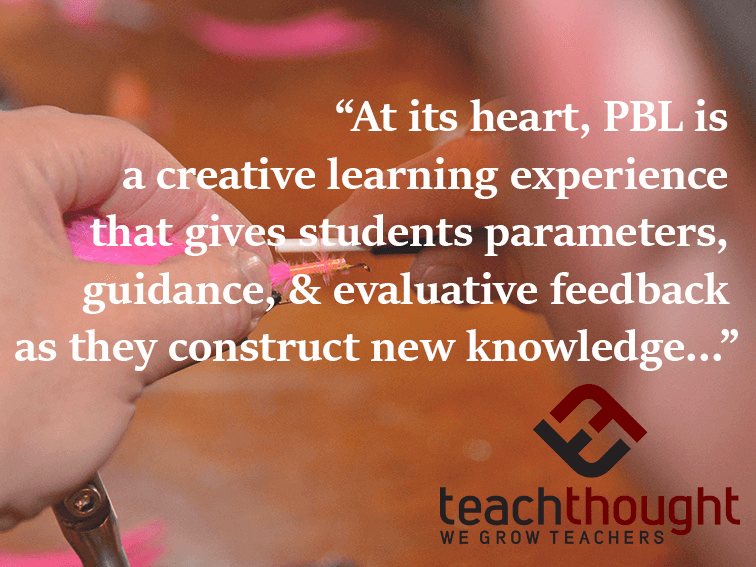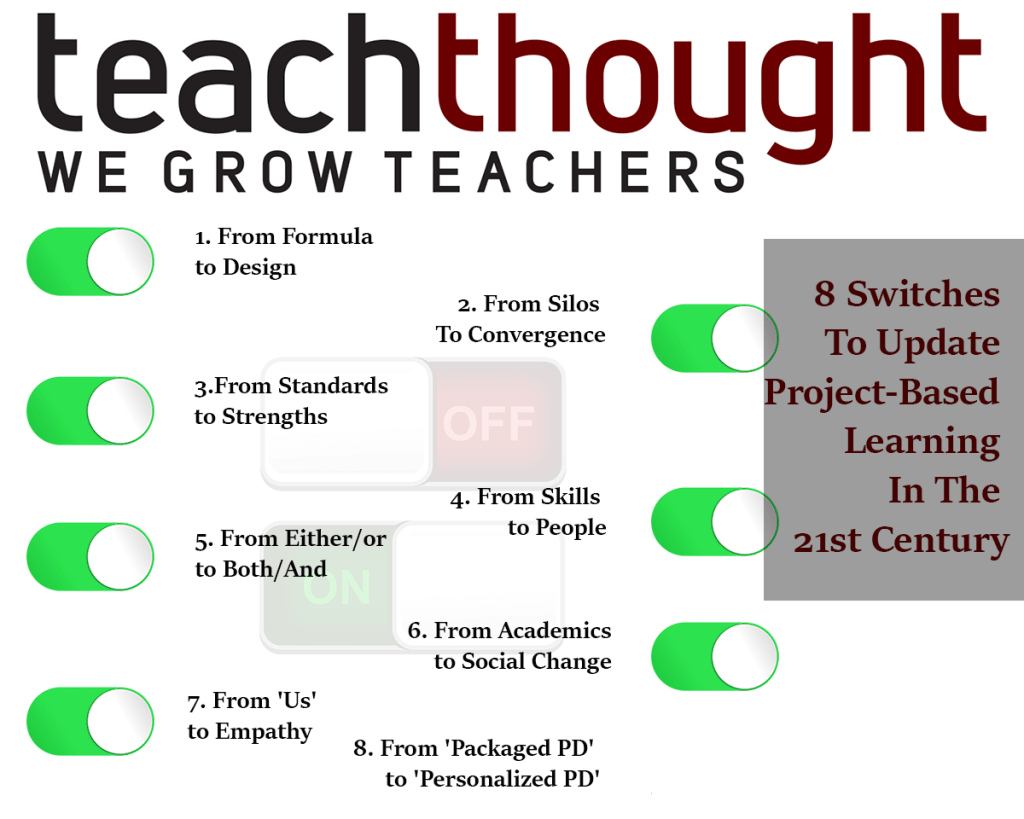
Update Project-Based Learning In The 21st Century With These 8 Switches
contributed by Thom Markham
This post has been updated and republished
Here’s some simple math: 1.8 billion youth need to be educated for 21st Century life. And, given that 21st Century living increasingly demands sophisticated work skills, deep personal strengths such as curiosity, empathy, and flexibility, and the ability to think as well as absorb content, it better be good education.
What’s ‘good’ education? That debate is fading. Increasingly, a consensus has formed around systems of teaching and learning that respect personalization, critical inquiry, problem solving, design thinking, conceptual mastery, and technical competency rather than dated academic metrics. Mostly the conversation is framed by references to project-based learning, which is emerging as a worldwide alternative to front of the room, traditional, teacher-centered instruction.
It’s important to understand that this is a global movement. From Finland to China to Peru to Canada to Dubai—and nearly everywhere else—some variation on the PBL theme is underway, as educators in every country seek to respond to increased student agency and overt signs of student dissatisfaction.
This provides educators with a window of opportunity to share best practices around PBL and contribute to a worldwide, collaborative conversation on personalized learning, inquiry, and the way educators ‘hold’ students in their minds eye. PBL doesn’t solve all issues around schooling, but the networked power of many educators will eventually yield the right system to support 21st century learning.
This opportunity to help shape—not drive or direct, but shape—the outcome for PBL across the globe applies to U.S. educators as well, of course. But how much the U.S. can contribute is in doubt. Outside of exceptional pockets of innovation, a scripted, teacher-centered approach, with a relentless focus on standards, still characterizes too much PBL in the U.S.
See also A List Of Examples Of Essential Questions
Call it the NCLB hangover, but the end result is watered-down PBL, often supported by trainers and consultants, that isn’t designed to doesn’t change the equation between teaching and learning. This is not a model that the U.S. should be proud to export, nor one that other countries, which have moved on or never were obsessed with standards, will import.
It’s beyond time for U.S. schools engaged in PBL to shift their emphasis. Rather than seeing PBL as a ‘strategy’ to meet accountability goals, educators should view PBL as a philosophical north star to guide us into the future, and to enlarge the frame for PBL by embracing key principles that will contribute to a global standard for PBL. In fact, for the health of U.S. education, as well as other systems, it’s time to rise higher, and in these dangerous, chaotic times, to define a future-version of inquiry-oriented PBL that needs to be implemented right now.
How can U.S.-based PBL educators contribute to the global conversation? Here are eight ideas, in rough sequence.
8 Switches To Update Project-Based Learning In The 21st Century
1. From Formula to Design
Solid PBL methods form the foundation for good project design, but great PBL depends on a fluid, personalized, knowledgeable, and mindful approach from the teacher/facilitator, who operates as part of a triad of environment, students, and teacher needs and direction.
This is far too complex to reduce to a simple series of steps on a great graphic. PBL uses proven, field-tested best practices, but PBL and project design should be presented to teachers as a design challenge in itself.
2. From Silos To Convergence: Merge PBL, Design Thinking, and Inquiry
Letting go of a formulaic approach to PBL is helpful for revealing its real potential as an investigative and design process that leads to outcomes other than those designated by the system. It is not enough to ‘meet’ standards or, worse, ‘exceed’ standards. At its heart, PBL is a creative learning experience that gives students parameters, guidance, and evaluative feedback as they construct new knowledge, solve open-ended problems, or practice the skills of innovation.
3. From Standards to Strengths
The above is not an argument for doing away with standards. But the overriding problem with an exclusive focus on standards is that information and content by themselves do not spur greatness, elicit deep personal strengths, or tap into the challenges and rewards experience in the inner life. Yet today’s world is going to challenge every one of those 1.8 billion youth to find and use their inner reserves.
The answer is neither to abandon core knowledge nor turn all education into an exploratory experience. But it is incumbent on adults to provide deep, meaningful challenge as often as possible in school. PBL, when well-constructed, achieves this goal. Every student should go through a series of meaningful projects during the year; anything else is a disservice.
4. From Skills to People
If inner reserves are mandatory for success, then the five core strengths that virtually everyone on the planet agrees to be vital—empathy, curiosity, flexibility, resiliency, and persistence—must be intentionally taught and assessed in school.
In PBL, these personal strengths can be surfaced through challenge, reflection, discussion, awareness, and a myriad of ways that good teachers know. It’s imperative that the old model of social-emotional learning, as distinct from academic learning, be discarded. Strengths, skills, and knowledge now operate in the world as one integrated package.

5. From Either/or to Both/And
PBL is neither student-centered nor teacher-centered, so it’s time to let go of this debate. It’s a communal process, with responsibility constantly shifting between parties as they navigate the problem-solving process, share useful facts and information, speculate together on outcomes, and support in one another the skills and strengths of the new world. In school, as in life and work, it is now a ‘both/and’ world that requires transparent communication, respectful collaboration, and redefinitions of the line between the teacher and the learner.
6. From Academics to Social Change
One of the core drivers of achievement is the power of purpose. While preparing for college still results in purposeful learning, there is a sense that a drifting world is in need of more service from its youth, who are asking for that opportunity. PBL is inherently a service-oriented form of instruction; many of the best project ideas revolve around meaningful social or environmental change.
PBL provides a potent vehicle for blending academic knowledge in service to a community or a cause. Blending the two goals of intellectual competence and inspired commitment is a necessary task for the future—and may be critical to tapping the creative, purposeful power of today’s adolescents.
7. From ‘Us’ to Empathy
Make Openness the Key Virtue
Without a world that can get along, there won’t be a global education system, just a collection of fortresses with their own narrow vision of right and wrong. With this future looming, humility, respect, and empathy—the behaviors that define openness—become the underpinning for great education, PBL or otherwise.
But PBL, with its collaborative problem solving, teaming, and contact with the community, offers superb opportunities for learning and practicing the kind of open attitude necessary in the diverse, inquiry-based, constructivist, collaborative, distributed knowledge, and individually empowered world of today.
8. From ‘Packaged PD’ to ‘Personalized PD’
Finally, the skill set of the successful PBL teacher cannot be mastered through conventional professional development.
PBL requires teachers who:
can be sensitive to the needs of students
can abide by the constraints of time and effort required
will understand the balance between skills and content
be able to coach the willing and the unwilling through a deep learning experience
know how to evaluate learners by both traditional and non-traditional metrics
have the ability and openness necessary to coach teams and individuals simultaneously
respond on the fly to the inevitable breakdowns as the project rolls out
And that’s only the beginning.
Developing this deep skill set can’t accomplished through ‘receiving’ traditional professional development from trainers; instead, it requires that teachers engage in personalized exploration themselves, through professional learning networks, tailored online learning, deep collegiality with peers, and fealty to the old adage, ‘know thyself.’
Thom Markham, CEO of PBL Global, offers world class online training in PBL for teachers and schools. A speaker, writer, psychologist, and internationally respected consultant in inquiry based education, 21st century skills, project based learning, and innovation, Thom is the author of the best-selling Project Based Learning Design and Coaching Guide: Expert tools for innovation and inquiry for K-12 educators and Redefining Smart: Awakening Student’s Power to Reimagine Their World, as well as the co-author of the Project Based Learning Handbook, published by the Buck Institute for Education.

